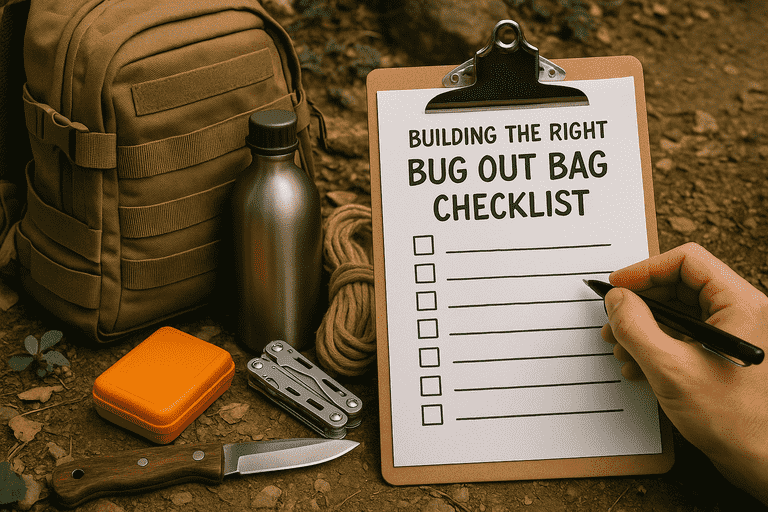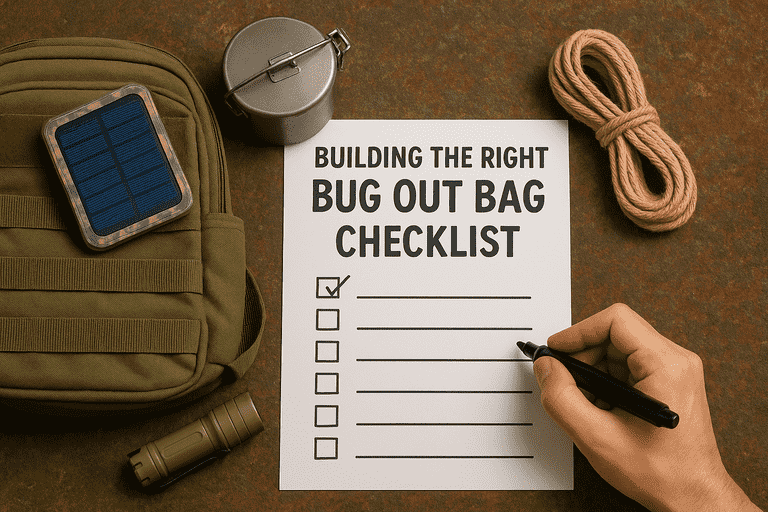When disaster strikes, time becomes your most precious resource. Whether it’s an earthquake, flood, wildfire, or civil unrest, having a reliable bug out bag checklist ensures you’re ready to act fast and efficiently. This checklist is your survival blueprint, guiding you through the must-have gear needed for 72 hours of self-sufficiency during an evacuation.
No matter where you live or what kind of threat you face, preparation starts with planning. A properly designed bug out bag checklist helps reduce panic, eliminate guesswork, and gives you a significant advantage when the unexpected happens.
Bug Out Bag Checklist: Core Survival Priorities
Every emergency kit should focus on five key survival needs: water, food, shelter, tools, and first aid. Without these basics, even the most experienced survivor is vulnerable.
A well-balanced bug out bag checklist starts with assessing what’s most important for your situation. Are you prepping for extreme cold? Urban unrest? Long travel on foot? Tailoring your kit begins with understanding the essentials and planning accordingly.

Water and Hydration in a Bug Out Bag Checklist
Access to clean drinking water is critical. Your checklist should always include:
- A minimum of 3 liters of water per person
- A collapsible water bottle or hydration pack
- Portable water filters or purification tablets
- A metal container for boiling water over a fire
In emergencies, water sources may be unsafe or scarce. With the right tools, you can turn even questionable water into a safe supply.
Food Storage and Energy
Food keeps you energized, focused, and strong. Your gear should provide:
- Lightweight, high-calorie meals (like freeze-dried or MREs)
- Protein bars and trail mix
- Portable stove and compact cookware
- Instant coffee or electrolyte drink packets
The idea is to pack food that’s easy to carry, requires little or no preparation, and keeps well over time.
Adapting Your Bug Out Bag Checklist to Your Environment
Where you live and the risks you face will influence your gear choices. An urban dweller may need more navigation tools and personal defense items, while someone in a rural area might prioritize outdoor survival tools.
As your life circumstances change—moving, having children, or developing medical needs—your bug out bag checklist should evolve with you. A good practice is to review and update it at least twice a year.

Tools and Multi-Use Gear You Should Include
The right tools can help you create shelter, start a fire, or signal for help. Make room for:
- A quality multi-tool with blade, pliers, and screwdriver
- Fire-starting options: waterproof matches, lighter, ferro rod
- Duct tape and cordage (paracord recommended)
- Flashlight or headlamp with extra batteries
Don’t overlook small tools—they often make the biggest difference in a survival situation.

First Aid Essentials to Match Your Bug Out Bag Checklist
Injuries are common in chaotic environments, so a well-stocked first aid kit is a must. Include:
- Gauze, bandages, antiseptic wipes, and adhesive tape
- Over-the-counter pain relief and allergy meds
- Tweezers, medical gloves, and scissors
- Prescription medications and emergency dosage
It’s also smart to add personal hygiene items like hand sanitizer, toothbrush, toothpaste, and feminine products to your checklist.
Mistakes to Avoid
Even the most detailed plans can fall short if basic mistakes are made. Some common errors include:
- Overpacking non-essential gear
- Using poor-quality tools or food
- Forgetting to rotate food and medicine every few months
- Not practicing how to use included items
A true bug out bag checklist isn’t just about items—it’s about understanding their purpose and function. You should be able to unpack and deploy any item in the dark, under stress, and in bad weather.
Final Thoughts: Building the Right Bug Out Bag Checklist
A complete bug out bag checklist is more than just a prepper’s tool—it’s your insurance policy when society, infrastructure, or nature fail. With smart planning and regular maintenance, your emergency kit becomes a source of confidence, not just gear in a backpack.
Take time to personalize your checklist to reflect your family, your risks, and your region. When disaster strikes, you won’t regret having prepared.

